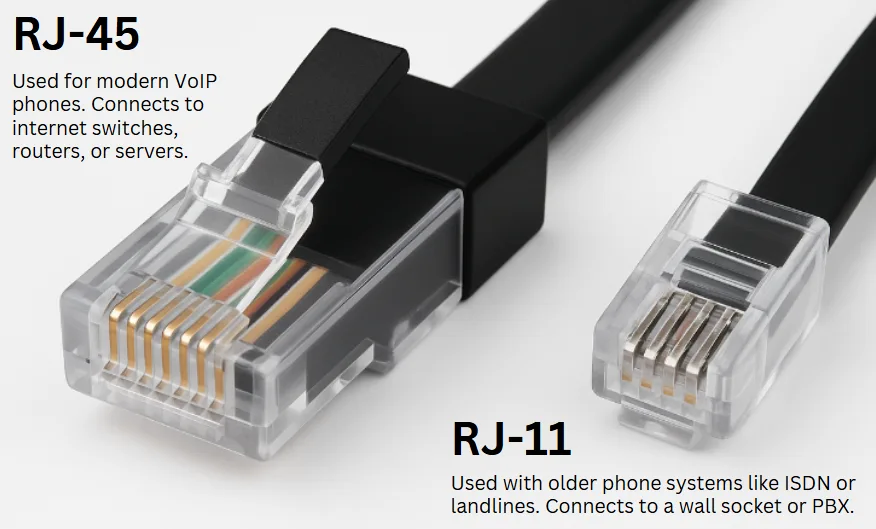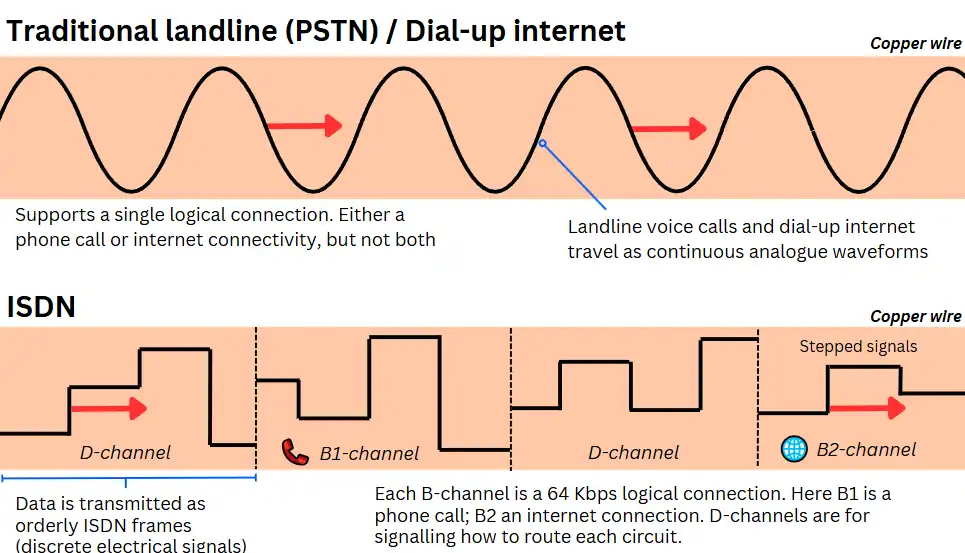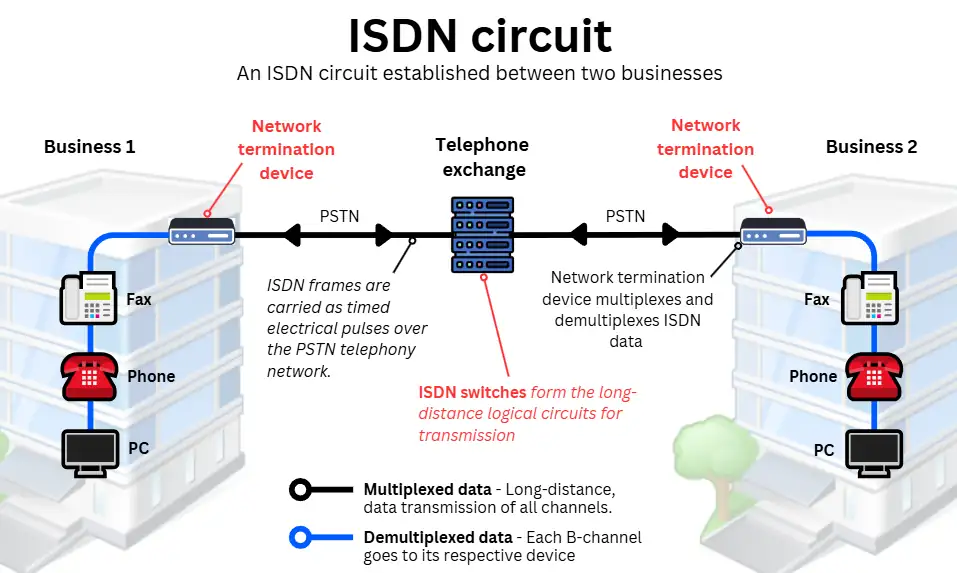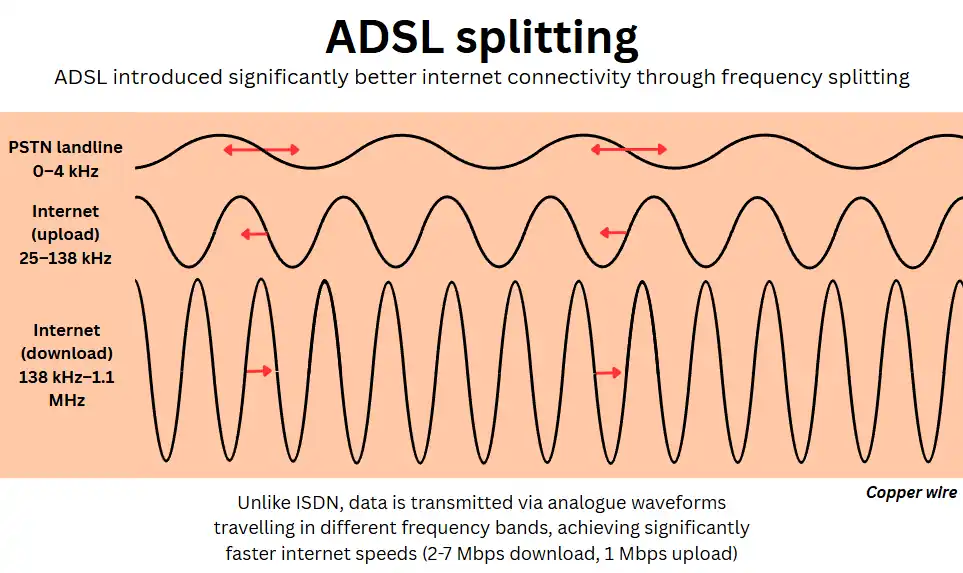Integrated Services Digital Network (ISDN) explained
ISDN is a legacy phone and internet system that revolutionised business telecoms by supporting simultaneous phone calls and 128 Kbps internet access.
While internet connectivity has since moved on to fibre, mobile, and even satellite broadband, thousands of UK businesses still rely on ISDN multi-line phone systems for voice communication, even as a nationwide switch-off is scheduled for January 2027.
This article explains how ISDN works, why it’s being phased out, and what alternatives your business can adopt to avoid disruption.
Contents:
- What is ISDN?
- How does ISDN work?
- Why is ISDN being switched off?
- ISDN switch-off timeline
- What will the ISDN switch off affect?
- What are the alternatives to ISDN for businesses?
- What should businesses do before the ISDN switch off
What is ISDN?
ISDN (Integrated Services Digital Network) is a legacy telecommunications technology designed to transmit digital voice and internet data over analogue copper telephone lines.
It gained popularity among businesses in the 1990s as it enabled multi-line phone systems and internet access via a single copper connection.
The key innovation was its ability to support simultaneous voice calls and internet connectivity, a major improvement over 56 Kbps dial-up connections (i.e. the ones with the familiar screeching sound), which could only handle one function at a time.
However, with the arrival of faster and more affordable ADSL broadband in the early 2000s, ISDN’s role shifted to primarily supporting business phone systems.
Despite its continued use, ultimately ISDN is a technology in decline. UK telecoms providers stopped offering new ISDN lines years ago, and support for existing systems is scheduled to end in January 2027 as part of the PSTN switch-off.
How do businesses use ISDN?
Thousands of UK businesses still rely on ISDN phone systems due to several practical reasons:
- Reliability: ISDN lines are known for consistent call quality and high uptime.
- High replacement costs: Many organisations use established PBX systems that are expensive to upgrade or replace.
- Legacy system compatibility: Many older alarms, lift phones, and fax machines still depend on a business ISDN connection.
- Connectivity in remote areas: ISDN provides dependable phone service in rural and underserved regions, leveraging existing copper telephone lines.
As a result, ISDN phone systems are still commonly found in rural businesses and public institutions, including GP surgeries, care homes, schools, legal practices, countryside guesthouses, small industrial operations, and even radio stations.
How do I identify an ISDN phone system?
The simplest way is to inspect the desk phones. If they connect using a traditional RJ-11 connector (rather than the more common RJ-45 used in modern networks), the system is likely ISDN or PSTN:

The phone cables typically run into a wall socket or PBX system, rather than into network switches, WiFi routers, or LAN servers as found in IP-based setups.
How does ISDN work?
ISDN represents a major improvement over early dial-up internet services and traditional landline telephony.
To best explain how it works, we first compare it to earlier technologies, then explore its inner workings in more detail:
- ISDN vs PSTN landline and dial-up internet
- ISDN channels and circuits
- ISDN network termination devices and switches
- ISDN communication in practice
- ISDN internet vs ADSL internet
ISDN vs PSTN landline and dial-up internet
Before ISDN, landline voice calls and dial-up internet data were both transmitted as continuous analogue waveforms over the PSTN (Public Switched Telephone Network).
Each copper line extending into a property could only support one function at a time, either a phone call or an internet session, with dial-up maxing out at 56 Kbps.
ISDN changed this by introducing digital signalling (i.e. discrete electrical signals) to replace the continuous waves used in dial-up and landlines. Both still use electrical signals over copper, but ISDN’s digital format is far more efficient and reliable.
Unlike analogue waveforms, digital signals can represent multiple logical channels, enabling simultaneous phone calls, fax messages, and internet connections, all over a single copper line.

In practice, this means employees in a business with ISDN can be on multiple phone calls at once, receive fax messages, and stay connected to the internet, all without needing multiple lines.
ISDN channels and circuits
Each ISDN connection is divided into separate channels, each serving a specific purpose:
- B-Channels (Bearer channels): Carry user data (e.g. voice, fax, internet traffic) at 64 Kbps each. Multiple B-channels can operate independently.
- D-Channels (Delta channels): Handle control and signalling, such as call setup and teardown. These run at 16 Kbps in Basic Rate Interface (BRI) and 64 Kbps in Primary Rate Interface (PRI).
In other words, D-channels determine when to start and stop sending the data being carried by B-channels, and where that data needs to go.
The data itself travels in the form of ISDN frames: structured and discrete digital packets transmitted along the copper line.
These frames are separated into their respective channels, each forming a digital circuit between two endpoints.
For example, one frame might carry a portion of an image from a website (internet B-channel), while another carries the sound of a phone conversation (voice B-channel).
Because each ISDN circuit has a fixed bandwidth (64 Kbps per B-channel), communication quality is consistent and predictable, especially relevant for voice calls that only require small amounts of data.
ISDN network termination devices and switches
ISDN relies on two main pieces of infrastructure to operate: network termination devices and switches.

ISDN network termination devices
When a stream of ISDN frames reaches its destination, the signal is demultiplexed using Time Division Multiplexing (TDM), a method that splits the stream into its original logical channels.
Each channel is then routed to its relevant device on the local business network: voice channels go to desk phones, fax messages to the fax machine, and data to the internet router or PC.
ISDN switches
ISDN switches are responsible for creating and managing the circuits that connect businesses and servers across the UK and beyond.
These switches sit within local telephone exchanges, and their job is to route ISDN data between endpoints until the D-channel signals that the session should end.
ISDN communication in practice
Here’s how a typical ISDN voice call works:
1. Call initiation (signalling via D-channel)
When a user dials a number, the ISDN phone sends a digital setup request via the D-channel. This includes the dialled number, caller ID, service type and other metadata.
The request travels to the ISDN switch at the local telephone exchange, which checks for capacity and begins establishing a call route.
2. Channel allocation (B-Channel setup)
If capacity is available, the ISDN switch assigns a B-channel for the call and notifies the calling device via the D-channel.
This B-channel becomes a dedicated, circuit-switched path for the duration of the session.
3. Data/voice transmission (over copper)
The user’s voice is digitised (often with codecs like G.711) and transmitted as a stream of electrical signals across the copper line.
These signals follow digital framing standards, and TDM enables multiple users to share the network backbone without conflict.
The circuit remains fixed for the call’s duration, maintaining consistent performance.
4. Call termination
When the call ends, the device sends a termination signal through the D-channel. The switch releases the B-channel and frees up all associated network resources for future use.
ISDN internet vs ADSL internet
We mentioned earlier that ADSL pushed ISDN into a role purely for business phone systems in the early 2000s by offering much faster and more affordable internet access.
Instead of transmitting fixed-size digital frames like ISDN, ADSL splits the copper line into multiple analogue frequency bands, each with its own bandwidth.
The lower frequencies are reserved for traditional analogue voice calls (PSTN), while the higher frequencies carry modulated digital data for internet use.
This separation allows for much faster internet speeds without interrupting phone service, both can operate simultaneously over the same line.

ADSL also introduced broadband asymmetry, delivering faster download than upload speeds to match the way people typically used the internet at the time, consuming far more content than they sent.
This innovation laid the foundation for modern broadband, effectively ending ISDN’s role in internet connectivity, though many businesses continue using ISDN for voice services.
Why is ISDN being switched off?
The telecoms industry in the UK and globally is phasing out ISDN and PSTN services in favour of fully IP-based infrastructure.
In the UK, Openreach is switching off all ISDN and PSTN services by January 2027, with many other countries in Europe on similar timelines.
This shift is driven by a need to simplify the network, reduce operational costs, and support the bandwidth, flexibility, and functionality required by modern communications.
These can be summarised into four key points:
1. Limited speed and bandwidth
Compared to contemporary broadband technologies, ISDN lines are inherently limited in capacity.
Each B-channel supports only 64 Kbps, and even when bonded (as in ISDN2e), the total throughput is just 128 Kbps, tolerable in the 1990s, but completely unfit for today’s requirements.
For comparison:
- A single HD video stream requires 2–5 Mbps (20 – 100x ISDN capacity)
- Cloud apps often require 10 Mbps or more
- Full fibre business broadband offers speeds of 100–1,000 Mbps (up to 10,000x faster)
The use of copper-based lines means ISDN simply cannot scale to support these demands, regardless of the condition.
2. High maintenance costs and limited support
Supporting ISDN infrastructure is increasingly expensive. It relies on legacy digital switches, bespoke hardware, and specialised engineering expertise, all of which are disappearing.
Fewer technicians are trained to work on ISDN, and spare parts are increasingly harder to source.
Modern IP-based services, by contrast, are cloud-compatible, modular, and software-defined, making them far easier and cheaper to upgrade, manage and scale.
3. Inferior capabilities compared to IP-based systems
IP-based communication systems (like business VoIP phone systems or UCaaS) offer many advantages over ISDN, including:
- Higher efficiency: Packet-switching uses bandwidth more intelligently than ISDN’s fixed circuits.
- Scalability: New users or lines can be added virtually without the need for new physical lines.
- Flexibility: VoIP through mobile devices enables access across locations and devices.
- Integration: VoIP integrations connect phone systems with CRM systems, video conferencing, messaging apps, and more.
- Global compatibility: VoIP and SIP are now universal standards, making international communication simpler and cheaper.
These capabilities align with how businesses operate today, with remote or hybrid teams and heavy use of cloud platforms.
4. Efficiency and sustainability goals
ISDN hardware consumes more power per connection than modern IP networks. The energy demands of copper-based systems and old switching equipment contribute to higher emissions and operating costs.
While sustainability isn’t the primary driver, retiring legacy networks helps telecoms providers cut power use, consolidate infrastructure, and reduce their carbon footprint, in line with tightening environmental targets.
ISDN switch-off timeline
The ISDN switch-off follows the same timeline as the UK’s Public Switched Telephone Network (PSTN) shutdown.
Here are the key dates businesses should be aware of:
- December 2025: The original deadline for withdrawing ISDN and PSTN services. This was postponed due to delays in fibre deployment and slow migration rates.
- January 2027: The revised and current target for full switch off. By this point, all customers must have migrated to IP-based voice or alternative telecom solutions.
- Post-2027: Decommissioning of legacy infrastructure begins. Telecom providers will refocus investment on fibre-first and 5G business broadband services.
Businesses still relying on ISDN should start preparing their migration plan now to avoid disruption and ensure a smooth transition.
What will the ISDN switch-off affect?
The ISDN switch-off will affect any service that relies on the UK’s traditional copper telephone network, not just landline phones.
Thousands of businesses still use systems that quietly depend on ISDN or PSTN, so the impact can be broader than expected.
Voice systems and phone lines
All ISDN-connected phone systems will stop functioning unless they are adapted to VoIP via SIP Trunking.
This includes:
- Business multi-line phone systems that rely on ISDN for simultaneous calls over copper.
- PSTN landlines (usually a single line), including those bundled with broadband packages like ADSL or FTTC.
The good news is that multi-line can be adapted to VoIP via SIP Trunking, and a bundled PSTN line simply needs a SoGEA broadband (which comes with a VoIP line) upgrade to keep working beyond the switch off.
ISDN-reliant systems and equipment
Any hardware that connects directly over ISDN lines will need to be retired or replaced.
This includes:
- Video conferencing systems
- Industrial monitoring or telemetry equipment
- Older point-of-sale terminals (PDQs or “Process Data Quickly” devices)
- Fax machines that use analogue lines may also stop working unless switched to digital alternatives.
Unfortunately, many of these industrial and legacy devices are not compatible with IP networks and will simply cease to function after the PSTN switch off.
Alarms, lifts and emergency systems
Many safety-critical systems still use ISDN or PSTN lines to dial out in emergencies.
This includes:
- Intruder and fire alarms
- Lift emergency phones
- Telecare and remote health monitoring devices
All such systems must be upgraded to IP-based or cellular-enabled alternatives to remain operational beyond 2027.
What are the alternatives to ISDN for businesses?
While ISDN was once used for internet access, UK businesses moved on from that decades ago, first into ADSL, and later into fibre, mobile, wireless leased lines and business satellite broadband in rural areas.
However, many businesses still rely on ISDN multi-line phone systems for internal and external voice communication. With the ISDN switch-off approaching in January 2027 (pending further delays), these setups will no longer be supported and will require replacement.
Here are the three main alternatives to consider:
SIP trunking
Best alternative for: Businesses that want to keep their existing multi-line phone systems.
What it is: SIP Trunking converts ISDN voice traffic into VoIP, allowing your existing PBX to route calls over a broadband connection.
Advantages:
- Preserves your current phone system, handsets, call routing, and workflows.
- Cuts line rental and call costs significantly.
- Requires minimal change, only a business VoIP provider and a SIP gateway or adaptor.
- Keeps your business landline number.
Disadvantages:
- Lacks access to modern VoIP features like AI call analytics or VoIP integrations like with CRM or ERP, as well as smart IVR systems.
- It’s a short-to-medium-term solution; it’s not future-proof.
Full switch to VoIP (hosted or cloud-based)
Best alternative for: Businesses looking to modernise fully and enable flexible, cloud-based communication.
What it is: VoIP (Voice over Internet Protocol) routes calls over your internet connection, using IP phones, apps, or laptops. Most businesses use cloud-hosted VoIP, while some opt for self-hosted systems for cybersecurity compliance.
Advantages:
- Scalable, flexible, and rich in features.
- Enables remote and hybrid working.
- Includes advanced tools like call recording, analytics, CRM integration, video conferencing, and browser-based management dashboards.
- Keeps your business landline number.
Disadvantages:
Often requires significant infrastructure and training upgrades, including:
- Local area network upgrades: Implementing VLANs to segment IP phone traffic using network switches or rolling out mesh networks for extensive WiFi coverage.
- Wide area network upgrades: Implementing business Ethernet networks for multi-site connectivity or SD-WAN solutions for cloud app and remote worker integrations.
- Hardware overhaul: Deploying new IP phones, conference room phones, screens, etc.
- Employee training: To use advanced capabilities and for VoIP security awareness to defend against cybersecurity threats.
- Depends on internet stability: Network load balancing may be needed for larger setups.
Full switch to mobile-only business
Best alternative for: Microbusinesses, sole traders, or fully remote teams without fixed offices.
What it is: Some businesses now operate entirely via mobile phones and platforms like Zoom, WhatsApp, or Google Meet.
They rely on residential broadband connection (i.e. work from home), Guest WiFi, or a business dongle for connectivity.
Advantages:
- Fast, flexible, low-cost.
- No hardware needed. VoIP apps can deliver call menus, shared numbers, and voicemail via smartphones.
Disadvantages:
- Limited control over call routing, reporting, or availability across a team.
- Can feel unprofessional or fragmented in client-facing roles or high-call environments.
What should businesses do before the ISDN switch off?
With the ISDN switch off approaching, businesses should take clear steps to ensure uninterrupted service.
Even if you’re not using ISDN directly, related systems may still depend on it and could be affected once services are withdrawn.
Here’s what you should do:
- Audit your current phone system: Identify whether you’re still using ISDN lines or an ISDN-based PBX.
- Check for dependent systems: Include alarms, lift phones, card machines, fax lines, and telemetry devices.
- Speak to your phone provider: Confirm your disconnection timeline and if there are any available upgrade options through third-party partnerships.
- Assess broadband readiness: Ensure your broadband connection can reliably support VoIP at the required scale. If fibre optics are available in your area, a leased line broadband service usually offers the lowest latency connections.
- Choose your replacement: Decide between SIP trunking, cloud VoIP, or mobile-based solutions.
- Choose the level of service: Decide between a fully or partially managed solution through a managed service provider, or a fully independent solution.
- Plan for installation and testing: Schedule changes in advance to avoid service disruption.
- Train your team: Make sure staff understand how to use any new systems or tools.
- Budget for upgrades: Set aside funds for any required hardware, licences, or IT support.
- Check for power backup: Ensure IP phones can access emergency services during power cuts if needed.

